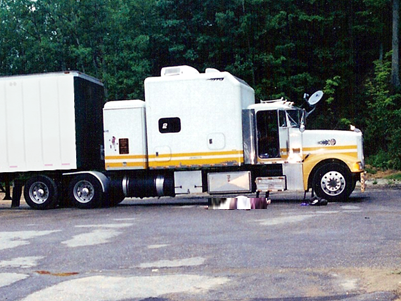A bloody body was found next to the dead man’s tractor trailer. Was it a homicide or an accident?

When a biker was found bloody and dead next to his tractor trailer one morning, it was immediately considered suspicious. He was parked in a partially paved vacant lot about 60 feet off of a main road. Only billboards surrounded the area. The biker was observed to unload his bike from the truck and drive off. A few hours later, he was seen returning and putting his bike back in the truck. A police officer drove around the truck at midnight. The biker was nowhere in sight, and all was quiet until a 911 call was made around 6am. A passing driver had spotted the biker’s body on the ground, next to the tractor trailer.
Every Unexpected Death Warrants Methodical Investigation
When I arrived at the scene. The body had not been moved. He was supine, near the open passenger door of the truck. The decedent looked to be about 50 years old and was dressed in a white T-shirt and striped pajama pants. He was barefoot. His arms were extended away from his body. It had been sprinkling and misting during the night and his clothes were wet. There was a halo of blood on the ground around his head.
Was This a Homicide?
Before touching the body, I obtained digital images to memorialize the scene. I carefully examined his hands, then lifted up his shirt to check his abdomen and chest. Grains of sand were adherent to the bottom of each foot. Rigor mortis was present. He had a large lump and a laceration on the back of his head. No other injuries were found.
The passenger door of the truck, which had been open when I arrived, was shut at the time the body was discovered. No one had entered the truck, due to the possibility of homicide and the need to preserve evidence. Sneakers, cigarettes, and caffeine pills were observed in the cab.
Putting Scene Clues Together
What was the decedent doing outside, during the night, in pajamas? It had to be after midnight and before 6am. Was he by himself? The sand grains on his feet were consistent with the sand on the floor mats of the truck. The feet would have been muddy had he been walking outside the truck. The message the scene conveyed to the experienced death investigator was that he was standing on the step up to the truck, with the door shut. Landing supine suggested he would have been facing the interior of the truck when he fell off. Why was he standing on the passenger doorstep in the middle of the night?
At this point, the small satellite dish on the passenger side mirror became more significant. Could the decedent have been attempting to activate the satellite dish when he fell? But how would he have seen what he was trying to do? There were no streetlights in the area. There were no lights on in the truck. No flashlight was present. A closer look at the surrounding billboards revealed light fixtures under them. A town maintenance official confirmed that the billboards lit up at night.
Closing the Circle
Lastly, did he die because he fell or fell because he died? Autopsy revealed no significant injuries. The lump on his head was just a soft tissue injury. There was significant heart disease, determined to be the cause of death. Manner of death was natural.
The First Chance is the Best Chance to Get it Right
Every case needs to be investigated methodically. Rushed conclusions at death scenes can result in lengthy and costly homicide investigations by law enforcement and the risk of a false accusation.

